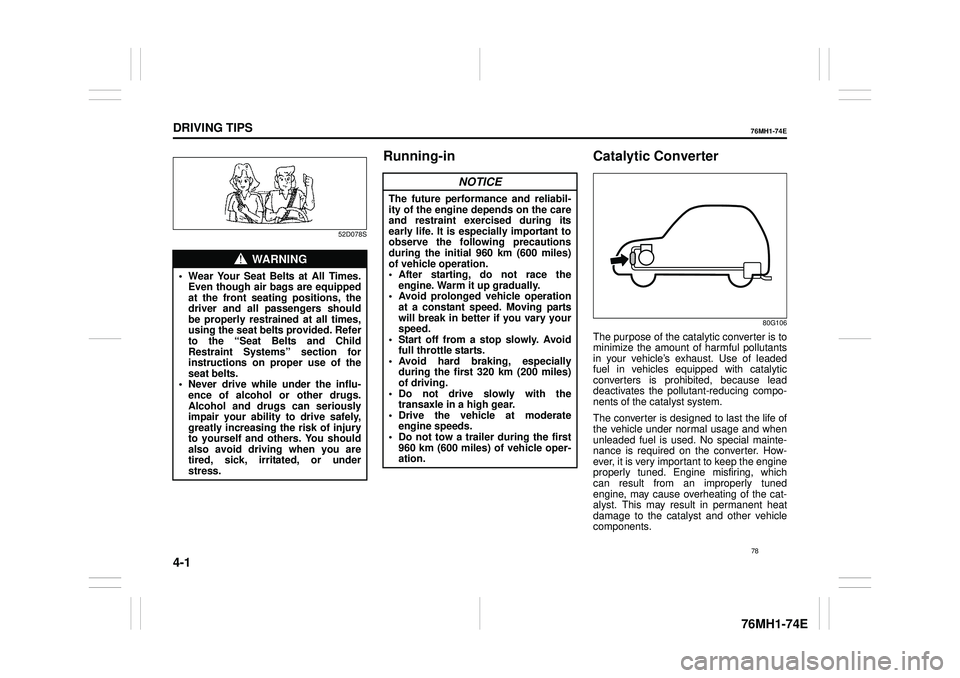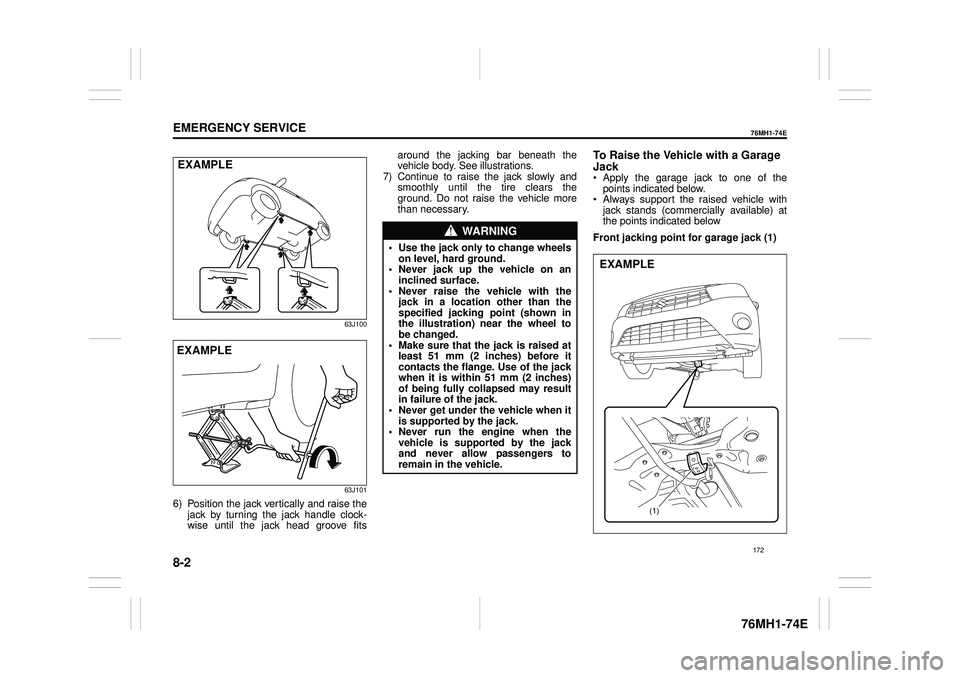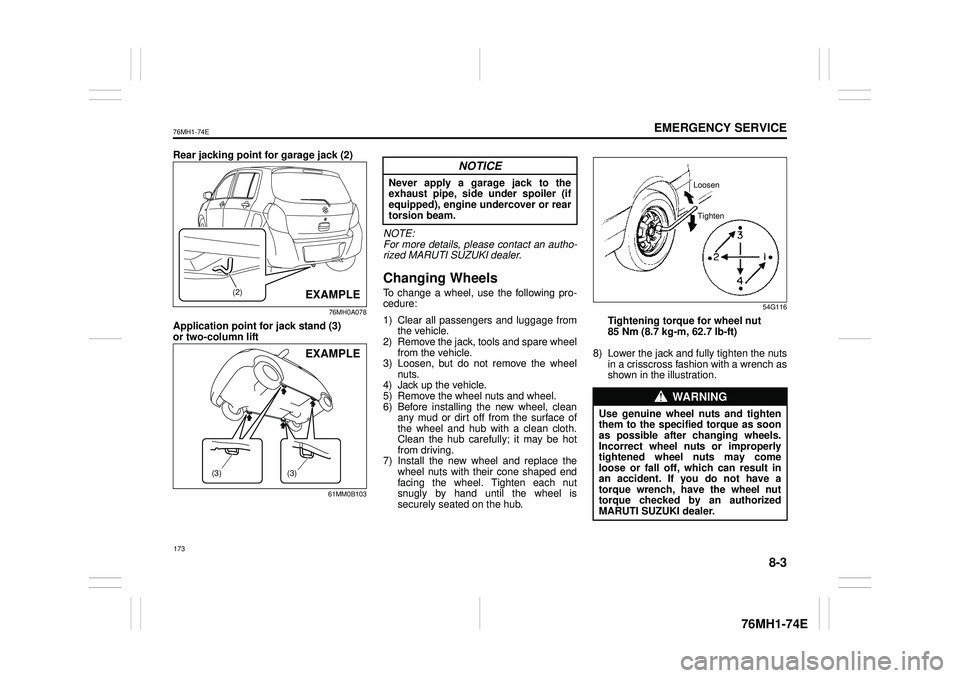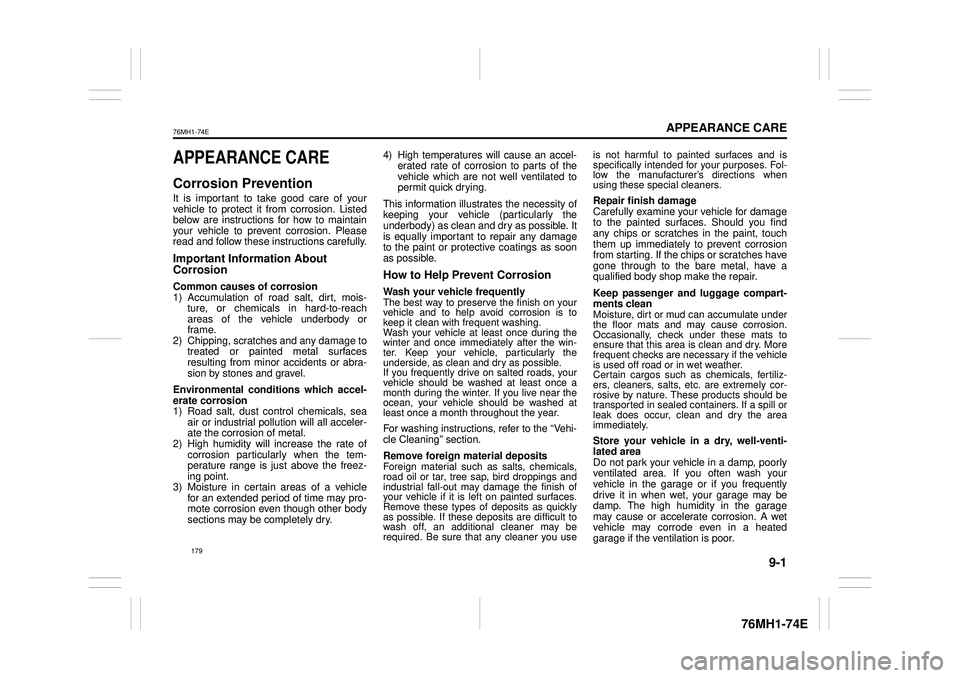passenger SUZUKI CELERIO 2022 User Guide
[x] Cancel search | Manufacturer: SUZUKI, Model Year: 2022, Model line: CELERIO, Model: SUZUKI CELERIO 2022Pages: 201, PDF Size: 5.82 MB
Page 89 of 201

4-1
DRIVING TIPS
76MH1-74E
76MH1-74E
52D078S
Running-in Catalytic Converter
80G106
The purpose of the catalytic converter is to minimize the amount of harmful pollutantsin your vehicle’s exhaust. Use of leaded fuel in vehicles equipped with catalytic converters is prohibited, because leaddeactivates the pollutant-reducing compo- nents of the catalyst system.
The converter is designed to last the life of the vehicle under normal usage and when unleaded fuel is used. No special mainte-nance is required on the converter. How- ever, it is very important to keep the engine properly tuned. Engine misfiring, whichcan result from an improperly tuned engine, may cause overheating of the cat- alyst. This may result in permanent heatdamage to the catalyst and other vehicle components.
WA R N I N G
• Wear Your Seat Belts at All Times. Even though air bags are equippedat the front seating positions, the driver and all passengers should be properly restrained at all times,using the seat belts provided. Refer to the “Seat Belts and Child Restraint Systems” section forinstructions on proper use of the seat belts. • Never drive while under the influ-ence of alcohol or other drugs. Alcohol and drugs can seriously impair your ability to drive safely,greatly increasing the risk of injury to yourself and others. You should also avoid driving when you aretired, sick, irritated, or under stress.
NOTICE
The future performance and reliabil- ity of the engine depends on the care and restraint exercised during its early life. It is especially important toobserve the following precautions during the initial 960 km (600 miles) of vehicle operation.• After starting, do not race the engine. Warm it up gradually. • Avoid prolonged vehicle operationat a constant speed. Moving parts will break in better if you vary your speed.• Start off from a stop slowly. Avoid full throttle starts. • Avoid hard braking, especiallyduring the first 320 km (200 miles) of driving. • Do not drive slowly with thetransaxle in a high gear. • Drive the vehicle at moderate engine speeds.• Do not tow a trailer during the first 960 km (600 miles) of vehicle oper- ation.
78
Page 183 of 201

8-2
EMERGENCY SERVICE
76MH1-74E
76MH1-74E
63J100
63J101
6) Position the jack vertically and raise the jack by turning the jack handle clock- wise until the jack head groove fits
around the jacking bar beneath the vehicle body. See illustrations. 7) Continue to raise the jack slowly andsmoothly until the tire clears the ground. Do not raise the vehicle more than necessary.
To Raise the Vehicle with a Garage
Jack Apply the garage jack to one of the points indicated below. Always support the raised vehicle with jack stands (commercially available) at the points indicated below.Front jacking point for garage jack (1)
EXAMPLE
EXAMPLE
WA R N I N G
• Use the jack only to change wheelson level, hard ground.• Never jack up the vehicle on an inclined surface. • Never raise the vehicle with thejack in a location other than the specified jacking point (shown in the illustration) near the wheel tobe changed. • Make sure that the jack is raised at least 51 mm (2 inches) before itcontacts the flange. Use of the jack when it is within 51 mm (2 inches) of being fully collapsed may resultin failure of the jack. • Never get under the vehicle when it is supported by the jack.• Never run the engine when the vehicle is supported by the jack and never allow passengers toremain in the vehicle.
(1)
EXAMPLE
172
Page 184 of 201

8-3
EMERGENCY SERVICE
76MH1-74E
76MH1-74E
Rear jacking point for garage jack (2)
76MH0A078
Application point for jack stand (3) or two-column lift
61MM0B103
NOTE:For more details, please contact an autho- rized MARUTI SUZUKI dealer.
Changing Wheels
To change a wheel, use the following pro-cedure:
1) Clear all passengers and luggage from the vehicle. 2) Remove the jack, tools and spare wheel from the vehicle.3) Loosen, but do not remove the wheel nuts. 4) Jack up the vehicle.5) Remove the wheel nuts and wheel. 6) Before installing the new wheel, clean any mud or dirt off from the surface ofthe wheel and hub with a clean cloth. Clean the hub carefully; it may be hot from driving.7) Install the new wheel and replace the wheel nuts with their cone shaped end facing the wheel. Tighten each nutsnugly by hand until the wheel is securely seated on the hub.
54G116
Tightening torque for wheel nut85 Nm (8.7 kg -m, 62.7 lb-ft)
8) Lower the jack and fully tighten the nuts in a crisscross fashion with a wrench as shown in the illustration.
(2)EXAMPLE
(3)(3)
EXAMPLE
NOTICE
Never apply a garage jack to theexhaust pipe, side under spoiler (ifequipped), engine undercover or rear torsion beam.
WA R N I N G
Use genuine wheel nuts and tighten them to the specified torque as soonas possible after changing wheels. Incorrect wheel nuts or improperly tightened wheel nuts may comeloose or fall off, which can result in an accident. If you do not have a torque wrench, have the wheel nuttorque checked by an authorized MARUTI SUZUKI dealer.
Loosen
Tighten
173
Page 190 of 201

9-1
APPEARANCE CARE
76MH1-74E
76MH1-74E
APPEARANCE CARE
Corrosion Prevention
It is important to take good care of your vehicle to protect it from corrosion. Listedbelow are instructions for how to maintain your vehicle to prevent corrosion. Please read and follow these instructions carefully.
Important Information About Corrosion
Common causes of corrosion 1) Accumulation of road salt, dirt, mois- ture, or chemicals in hard-to-reachareas of the vehicle underbody or frame. 2) Chipping, scratches and any damage totreated or painted metal surfaces resulting from minor accidents or abra- sion by stones and gravel.
Environmental conditions which accel- erate corrosion1) Road salt, dust control chemicals, sea air or industrial pollution will all acceler- ate the corrosion of metal.2) High humidity will increase the rate of corrosion particularly when the tem- perature range is just above the freez-ing point. 3) Moisture in certain areas of a vehicle for an extended period of time may pro-mote corrosion even though other body sections may be completely dry.
4) High temperatures will cause an accel- erated rate of corrosion to parts of the vehicle which are not well ventilated topermit quick drying.
This information illustrates the necessity of keeping your vehicle (particularly the underbody) as clean and dry as possible. It is equally important to repair any damageto the paint or protective coatings as soon as possible.
How to Help Prevent Corrosion
Wash your vehicle frequentlyThe best way to preserve the finish on your vehicle and to help avoid corrosion is tokeep it clean with frequent washing. Wash your vehicle at least once during the winter and once immediately after the win-ter. Keep your vehicle, particularly the underside, as clean and dry as possible. If you frequently drive on salted roads, yourvehicle should be washed at least once a month during the winter. If you live near the ocean, your vehicle should be washed atleast once a month throughout the year.
For washing instructions, refer to the “Vehi- cle Cleaning” section.
Remove foreign ma terial depositsForeign material such as salts, chemicals, road oil or tar, tree sap, bird droppings andindustrial fall-out may damage the finish of your vehicle if it is left on painted surfaces. Remove these types of deposits as quicklyas possible. If these deposits are difficult to wash off, an additional cleaner may be required. Be sure that any cleaner you use
is not harmful to painted surfaces and is specifically intended for your purposes. Fol- low the manufacturer’s directions when using these special cleaners.
Repair finish damage Carefully examine your vehicle for damage to the painted surfaces. Should you findany chips or scratches in the paint, touch them up immediately to prevent corrosion from starting. If the chips or scratches havegone through to the bare metal, have a qualified body shop make the repair.
Keep passenger and luggage compart- ments cleanMoisture, dirt or mud can accumulate under the floor mats and may cause corrosion. Occasionally, check under these mats toensure that this area is clean and dry. More frequent checks are necessary if the vehicle is used off road or in wet weather.Certain cargos such as chemicals, fertiliz- ers, cleaners, salts, etc. are extremely cor- rosive by nature. These products should betransported in sealed containers. If a spill or leak does occur, clean and dry the area immediately.
Store your vehicle in a dry, well-venti- lated area Do not park your vehicle in a damp, poorlyventilated area. If you often wash your vehicle in the garage or if you frequently drive it in when wet, your garage may bedamp. The high humidity in the garage may cause or accelerate corrosion. A wet vehicle may corrode even in a heatedgarage if the ventilation is poor.
179